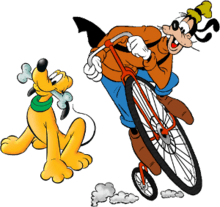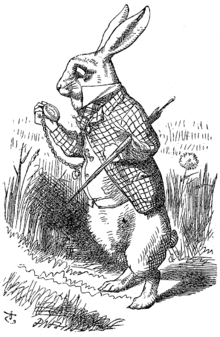Funny animal
| Funny animal | |
|---|---|
 Disney's Pluto consistently exhibits canine behaviors, like digging, barking, and chewing bones. Conversely, Goofy is a funny animal; he engages in behaviors such as walking upright, wearing clothes, and riding bicycles. Other characters acknowledge that Goofy is a dog, but he is still treated as a human. | |
| This topic covers comics that fall under various genres. |
A funny animal also known as a furry is an anthropomorphic animal character who lives like a human. Funny animals typically are bipedal, wear clothes, live in houses, drive and ride vehicles, and have jobs or may even be recognized citizens of countries, which distinguish them from other animal characters who may nonetheless display anthropomorphic characteristics such as speaking or showing facial expressions. Funny animal (also talking animal) is also the genre of comics and animated cartoons which primarily feature funny animals.[1]
While many funny animal stories are light-hearted and humorous, the genre is not exclusively comedic. Dark or serious stories featuring characters of this sort can also be grouped under the "funny animals" category, sometimes referred to as anthropomorphic characters[2] to avoid confusion over the range of genres. These stories may intersect with any other genre or group of genres, including historical fiction, science fiction, superhero, western, slapstick comedy, children's/family entertainment, and satire.[3]
History
Print media

Early examples of funny animal characters in literature can be found in Jean Ignace Isidore Gérard Grandville's Les Métamorphoses du Jour (1828-1829), a series of illustrations which anthropomorphized humans as animals [4] and in the 1865 book Alice's Adventures in Wonderland by Lewis Carroll with characters such as the White Rabbit and the March Hare.
The oldest funny animal comic strip is James Swinnerton's The Little Bears, which debuted in 1892. [5] The earliest example of funny animals in a British comic strip was Arthur White's Jungle Jinks (1898-1947), which featured a group of school children, anthropomorphized as animals. The comic strip ran in Playbox, a supplement of Home Chat, for years. [6] Jungle Jinks in particular paved the way for a whole stream of British comics about cute animal characters: Tiger Tim, Teddy Tail, Rupert Bear,... and so on. [7]
An early example of a novel which made exclusive use of funny animals was the 1908 children's book The Wind in the Willows by Kenneth Grahame. This story featured the character Mr. Toad who is human in almost every sense. Other characters in the book, such as a mole, water rat, and otter, are also very human with the exception of preferring their species' native habitats. The mole, for example, lives underground, but in a finished home.
In the United States the most well known funny animal comic was Krazy Kat (1913) by George Herriman. It featured a cat, a mouse Ignatz and a dog police officer named Offissa Pup. [8] Animated cartoons also inspired a whole industry of comics based on funny animal characters like Felix the Cat, Mickey Mouse, Donald Duck, Daffy Duck, Bugs Bunny, Tom & Jerry, Woody Woodpecker,...
The 1945 novel Animal Farm by George Orwell notably features several talking animal characters who transition to bipedal, clothes-wearing funny animals by the end of the story.
In the 1940s, Fawcett Comics published a comic book entitled Funny Animals, featuring such characters as Hoppy the Marvel Bunny, an anthropomorphic rabbit version of Captain Marvel.
Charles M. Schulz's dog character Snoopy from Peanuts and the title cat character of Jim Davis's comic strip Garfield are non-speaking pet characters, so are not strictly funny animals by the above definitions; however they are depicted with some funny animal traits, such as bipedalism and understanding of human language. Snoopy in particular writes books, plays baseball as a shortstop, and sometimes wears clothes when he indulges in his various fantasy lives, such as his college student persona known as Joe Cool.
Instead of verbalizing as humans would with speech balloon, Snoopy and Garfield instead use thought balloons to convey messages. This tactic allows for the relationship between human and animal to be ambiguous, as it may not be clear if the human can understand what the animal is thinking. When the Peanuts specials were adapted for television, producers opted to make Snoopy mute, just as a normal dog would be, and act out his thoughts in pantomime. The ambiguous relation between Garfield and his owner, Jon Arbuckle, inspired a number of derivative works, among them being Garfield Minus Garfield, a collection of strips with the title character edited out and Arbuckle effectively speaking to himself.
Since the mid 1960s subversions of the innocence of funny animal stories have been generated by the underground comix movement, with Robert Crumb's Fritz the Cat and Kim Deitch's Waldo the Cat as prime examples. Here the funny animals are portrayed doing drugs, having sex and acting far more violently than what mainstream media would dare to portray. Beginning in the 1980s, there was a subgenre of original funny animal comic books with subject matter that were created largely for mature readers. These creations included the political science fiction allegory in Albedo Anthropomorphics, the sexually explicit serial drama of Omaha the Cat Dancer, the noir style of Blacksad and the Pulitzer Prize-winning graphic Holocaust narrative, Maus.
U.S. Acres is the other comic strip created by Jim Davis, featuring a group of barnyard animals, such as Orson the pig and Wade the duck. They are closer to traditional funny animals than Davis' other character, Garfield, and they are shown to be able to operate manmade items,[9] speak with normal speech bubbles and converse with humans.[10] Pearls Before Swine features various funny animals each named after their respective species, such as the characters known as Rat and Pig.
Animated cartoons
The funny animal genre evolved in the 1920s and 1930s, at a time when blackface became less socially acceptable. Early black-and-white funny animals, including Oswald the Lucky Rabbit, Mickey Mouse, Foxy the Fox, Felix the Cat and Flip the Frog, maintained certain aspects of the blackface design, including (especially with the advent of sound film) heavy emphasis on song and dance routines. The increased use of Technicolor and other color film processes in the 1930s allowed for greater diversity in the ability to design new "funny animals", leading to a much wider array of funny animal shorts and the near-total demise (except for Mickey Mouse and a few other Disney characters of the era) of the blackface characters. Song and dance fell out of favor and were largely replaced by comedy and satire. The Looney Tunes and Merrie Melodies shorts by Warner Bros. Animation, for instance, introduced dozens of funny animals, many of whom have reached iconic status in American culture. Other notable funny animals from the color film era included Universal's Woody Woodpecker, Wally Walrus, Chilly Willy and Andy Panda; MGM's Tom and Jerry, Screwy Squirrel, Barney Bear and Droopy; and Terrytoons' Heckle and Jeckle, Gandy Goose, Dinky Duck and Mighty Mouse.
Television changed the dynamic of animation, in that although budgets were much smaller and schedules much tighter, this prompted a shift from the physical comedy that predominated film shorts to more dialogue-oriented jokes (including celebrity impressions and one-liner jokes). Hanna-Barbera Productions focused almost exclusively on these kinds of funny animal TV series, creating an extensive line of funny animal television series starring characters such as Huckleberry Hound, Yogi Bear, Snagglepuss and Top Cat. Jay Ward Productions also produced Rocky and Bullwinkle (also known as Rocky and his Friends, The Bullwinkle Show or The Rocky and Bullwinkle Show), a series starring a "plucky" flying squirrel named Rocky and his incompetent moose sidekick and best friend, Bullwinkle J. Moose, as they fought against Eastern European (human) espionage. The series was a representative of the genre (albeit with much stronger Cold War overtones than the shows of Hanna-Barbera exhibited); Ward was also responsible for the lighter funny animal series Super Chicken and Hoppity Hooper, and his contemporary Total Television (which used the same Mexican animation studio) produced a complementary string of animal cartoons of its own, famously Underdog.
By the 1970s, most funny animals had lost their lead status and had been relegated to members of an ensemble cast of mostly humans or supporting characters; the Scooby-Doo franchise, for example, inspired several ensemble mystery-comedies with funny animals existing alongside humans. During this period there were standout creations like Ralph Bakshi's iconoclastic feature animated film, Fritz the Cat. Funny animals and animal-like characters made a brief comeback in the late 1980s and into the 1990s (most notably through various Warner Bros. and Disney television creations, and through the decidedly cruder work of Bakshi and John Kricfalusi). The subsequent years also had numerous successful animated feature film franchises that featured funny animal characters like DreamWorks Animation's Kung Fu Panda series, Walt Disney Animation Studios' Zootopia and Illumination Entertainment's Sing. Artists have created increasingly more unusual examples of funny animals in this era, such as SpongeBob SquarePants from the Nickelodeon's TV series of the same name, who is unusual as he is a sea sponge, an animal that is seldom anthropomorphized; and the fish characters from Disney's Fish Hooks, who live similar lives to those of humans while living in a pet store aquarium. Netflix's BoJack Horseman features adult themes played out by a mixture of animals and humans who rarely mention their differences, and when the differences are mentioned it is sometimes taken as a racial slight.
See also
References
- ↑ Katalin Orban, Ethical Diversions: The Post-Holocaust Narratives of Pynchon, Abish, DeLillo, and Spiegelman, New York, London: Routledge, 2005, p. 52: "'funny animal' or 'talking animal' type of comics, such as Donald Duck, Mickey Mouse or Krazy Kat."
- ↑ M. Keith Booker (ed.), Comics through Time: A History of Icons, Idols, and Ideas, Santa Barbara, California: ABC-CLIO, 2014, p. 177.
- ↑ Markstein, Don. "Toonopedia: Funny Animal". Retrieved 2006-12-27.
- ↑ https://www.lambiek.net/artists/g/grandville_jj.htm
- ↑ https://www.lambiek.net/artists/s/swinnerton.htm
- ↑ https://www.lambiek.net/artists/w/white_arthur.htm
- ↑ https://www.lambiek.net/artists/w/white_arthur.htm
- ↑ https://www.lambiek.net/artists/h/herriman.htm
- ↑ https://garfield.com/usacres/1987/05/17
- ↑ https://garfield.com/usacres/1986/03/30
Further reading
- Williams, P.; Lyons, J. (2010), The Rise of the American Comics Artist: Creators and Contexts, University Press of Mississippi, ISBN 9781604737929
- Meskin, A. and Cook, R.T. and Ellis, W. (2011), The Art of Comics: A Philosophical Approach, John Wiley & Sons, ISBN 9781444354829
- Encyclopedia of Comic Books and Graphic Novels, ABC-CLIO, 2010, ISBN 9780313357473
External links
- Reading Room Index Guide Screen: Funny Animal - a list of funny animal comics, hosted by Michigan State University's library
